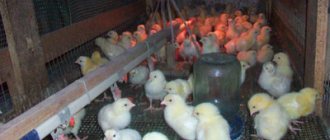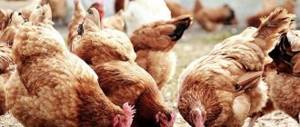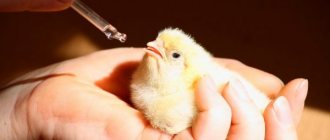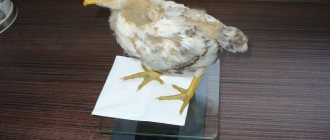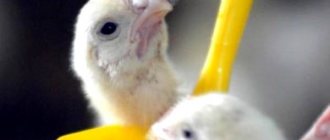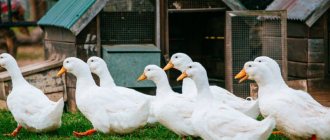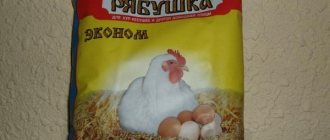0
1876
Article rating
To properly feed day-old chicks, you need to know everything about their needs in the initial stages of life. Food should be healthy and light. It is important to maintain routine and cleanliness. When the chicks receive the necessary nutrients, their bodies will develop properly and they will not get sick. The diet of egg and meat breeds is different.
General recommendationsogorod.ru/wp-content/uploads/2018/08/chem-kormit-sutochnyh-cyplyat2-300×225.jpg 300w, https://pro100ogorod.ru/wp-content/uploads/2018/08/chem- kormit-sutochnyh-cyplyat2-90×68.jpg 90w" sizes="(max-width: 600px) 100vw, 600px" /> Feeding day-old chicks
Conditions of detention
In the first month, especially the first 10 days, chickens need special care. They need a warm, dry, clean room with good ventilation, but without drafts. No more than 20...25 chickens should be placed per 1 m2. After 4...5 weeks they are planted in 17 heads each, and after 10 to 20 weeks - 10 heads per 1 m2.
For the first 3...5 days, it is better for chickens to lay paper on the floor, and sprinkle sifted chicken feed and fine corn grits on it. Chickens rummage in such litter without harm to themselves and remain clean.
You cannot feed chickens on a cold floor, otherwise they will catch a cold. In no case should chickens climb into feeders and drinkers with their feet: feed and water contaminated with droppings cause intestinal diseases, and wet litter is detrimental to immature chickens.
In the first 10 days, chickens are fed every 2 hours. During this period, the best food for them will be finely chopped hard-boiled eggs, crumbly cottage cheese mixed with semolina or corn grits. For 10 chickens, give one egg or 50 g of cottage cheese mixed with 50 g of cereal. It is useful to give chickens small cereals, lightly ground rolled oats, chicken feed, adding dry milk (1/4 of the volume of cereal or mixture of cereals) and one ground multivitamin tablet (for 10 chickens). This dry mixture is convenient because the poultry farmer can go away for a long time, pouring feed into the feeder, and the chickens themselves regulate their feed consumption. After each feeding, check that all chicks have full crops.
From 3...5 days of age, chickens are taught to eat finely chopped greens; at 5...7 days of age, it is good to give crumbly mash on yogurt, meat and fish broth, as well as meat and fish waste (5...7 g per head), with On the 10th day, boiled potatoes, grated carrots, pumpkin, zucchini and other vegetables are given. Wet crumbly mash should be eaten within 30...40 minutes (they give 30...40 g per head), the remains must be removed (soured feed causes poisoning and death of chickens). Fresh yogurt, kefir, and whey are very useful for the intestines of chickens, which are given in the morning, and then the drinking bowls are filled with fresh water. As a disinfectant, a weak solution of potassium permanganate is given 2 times a week for half an hour, but it should not be given immediately unless necessary in the first days of the chickens’ life.
Starting from 10 days of age, chickens are given finely crushed chalk, well-boiled ground eggshells, and separate feeders should always contain fine gravel or coarse sand.
In the first month, chickens are very demanding of heat; they die even at room temperature. For the first 5 days, the temperature in the area where the chickens are placed should be 29...30 °C, from the 6th day it is reduced to 26...28 °C and every subsequent week - by 3 °C, by the end of the month it is brought to 18 °C. It is good to heat chickens with infrared lamps: they do not glare and can be left overnight. In warm, sunny weather, chickens can be taken outside as early as 3 days of age. They get used to walking gradually.
Feeding the chickens
Chicks hatched under the hen. Now they have dried out and begin to peek out from under the wings. Watch them and you will see that the chickens are already pecking at something. They try to search for food soon after hatching.
Previously, many poultry farmers believed that chickens should be fed only on the second day of their life. It was a mistake. Poultry scientists say something else: the earlier you start feeding chickens, the faster their residual yolk is absorbed and they develop better.
Good feeds for chickens in the first days of their life are:
- finely crushed high-quality grain mixture;
- finely chopped hard-boiled egg;
- well-squeezed non-acidic cottage cheese;
- cool-cooked millet porridge.
From the very first days of growing, chickens should also be given finely chopped fresh greens - alfalfa, clover, nettle. Flour mixtures from grain, animal and mineral feeds are gradually introduced into the diet: first dry mixtures, and then wet ones. To moisten the mixtures, use whey with pressed yeast diluted in it.
Chickens up to one and a half to two months of age are given dry mixture as much as possible: the feeder with the dry mixture should be kept near the chickens at all times.
Until ten days of age, chickens are fed six times a day, from the tenth day to one and a half months of age - five times, and then switch to four feedings a day.
Previously, we said that feeders for wet mash should be washed and dried frequently, and when feeding chickens this is especially important: sour and contaminated feed causes diseases.
The number of feeders and drinkers must be sufficient, otherwise the chickens will interfere with one another.
The chicks' crops should be full after evening feeding. If there are chickens with an incomplete crop, they must be transferred to another room and fed separately.
Mineral feed should be kept in separate feeders.
The water needs to be changed several times a day.
Feeding Laying Chicks
Chickens of the egg production direction.
The young animals receive their first portions of feed on the day they are transferred to the poultry house or cage. A prerequisite is unlimited access to feeders and drinking bowls (not empty, of course).
For chicks under two months of age, abundant feeding is recommended.
Did you know? The maximum growth rate of young animals occurs in the first two weeks of life. Over a 14-day period, the chicken's weight increases approximately 15 times.
Important: chickens are fed strictly according to a certain regimen. Exceeding the established time frame may harm the chicks.
Feeding mode
The chickens begin to be fed immediately after they are dry and begin to move actively. Feeders and drinkers in the chicken coop are installed near the heating source. One to two hours before receiving the chicks, vacuum drinkers are filled with water so that it reaches the room temperature. For every 100 chickens, one drinking bowl is provided.
To feed the chickens in the first week, the floor near the heating is lined with paper in two or three layers. As it gets dirty, one layer of food residue is removed daily. For the smooth development of young animals, the length of the feeding front should provide simultaneous access to the entire livestock.
Feeder area per chicken depending on age
| Bird age (weeks) | Feeding front (cm/head) | |
| linear feeder | trough feeder | |
| 0-2 | 2,5 | 3,0 |
| 3-6 | 3-3,7 | 4,0-4,5 |
| 7-18 | 3,7-4,5 | 4,7-5,7 |
The frequency of feeding in the first 10 days is at least 8 times, from 11 to 30 days - 6-7 times, 31-45 days - 4-5 times. Subsequently, they switch to three feedings a day. Feeding must be done at regular intervals in the same place. Paper or tray feeders are gradually being replaced by grooved or round feeders. The thickness of the feed on paper or in the feeder should not exceed one centimeter in the first days.
From the 5-6th day, vacuum drinkers gradually begin to be replaced with trough drinkers. The watering margin per chicken under two weeks of age should be 1 cm, from two to six - 1.5 cm, from six and older - 2.5 cm.
During the first two days, chickens eat little, so the food should be highly nutritious and easily digestible. Minerals and gravel are given in separate feeders, starting from the fifth day of life.
Approximate daily diet of a chicken depending on age
| Feed (g) | Chick age (days) | ||||||
| 1-5 | 6-10 | 11-20 | 21-30 | 31-40 | 41-50 | 51-60 | |
| Crushed grain, (cereal) 2-3 types | 4 | 7 | 11 | 18 | 28 | 35 | 45 |
| Cake and meal | — | 0,2 | 0,5 | 0,6 | 1.2 | 1.5 | 2.0 |
| Boiled potatoes | — | — | 4,0 | 10,0 | 14,0 | 18,0 | 20 |
| Cottage cheese is fat-free. | 1.0 | 1.5 | 2,0 | 3,0 | 4,0 | 4,0 | 4.0 |
| Hard boiled egg | 2,0 | 2,0 | — | — | — | — | — |
| Dairy reverse, whey | 5 | 10 | 15 | 20 | 25 | 30 | 30 |
| Shell or chalk | — | 0,2 | 0,4 | 0,5 | 0,8 | 1.1 | 1.1 |
| Bone meal (crushed bone) | — | 0,2 | 0,4 | 0,5 | 0,8 | 0,9 | 0,9 |
| Fine salt | — | — | 0,05 | 0,05 | 0,08 | 0,1 | 0,1 |
| Fresh greens or red carrots | 1.0 | 3,0 | 7,0 | 10,0 | 15,0 | 17 | 20 |
With a combined type of feeding, in the absence of complete feed, finely chopped greens or carrots are fed to chickens from the first days of life. Fresh skim milk and whey are added to the wet mash. Souring dairy products and moldy feed should not be fed. With a combined type of feeding, crushed grain and millet are distributed in the morning and evening, wet mash - in the middle of the day.
Wet mash of dairy products is fed in such quantities that the chickens can consume it in 30-40 minutes.
Dry food mixture should be in the feeders at all times.
Provided that the diet is complete with dry feeding, 6 kg of feed will be required per head for the growing period up to 17 weeks of age.
To monitor the development of young animals, it is necessary to weigh the young animals every week at the same time of day. The assessment will be more reliable if you weigh the same individuals.
In case of significant deviations, the feeding level is adjusted.
Feeding chicks from two weeks
The set of basic protein feeds included in the diet of 10-15-day-old chickens consists of peas, cakes and meals. They are crushed before being added to the mash. The daily intake of protein feed is 2 g. Crushed grain is fed in the mornings and evenings.
Sometimes poultry farmers use fresh table waste instead of fish and meat and bone meal.
The above specified standards for feeding laying chickens: egg production direction. For meat and egg poultry they are approximately 11-14% higher.
Here are several diets offered for young animals of the egg production direction. So, from the 41st to the 50th day of life he is fed:
- Skim milk – 25 g;
- low-fat cottage cheese – 4 g;
- crushed grain – 39 g;
- fish meal – 3.5 g;
- cakes, meal, crushed peas – 3 g;
- garden greens – 15 g;
- boiled potatoes (can be replaced with root vegetables) – 30 g;
- mineral feed – 2 g;
- salt – 0.1 g.
The diet of 51-68-day-old young animals consists of:
- From skim milk (25 g);
- cottage cheese (5 g);
- crushed grain (48 g);
- meat and bone meal (4 g);
- cakes and meal (4 g);
- greens from the garden (15 g);
- boiled carrots, beets (40 g);
- mineral supplements, for example, shells and sand (2 g);
- and salt (0.2 g).
Types of feed
There are two main types of food: hard and soft. The first type includes mainly grains or grass seeds in their natural state, the soft type includes flour made from the same grains, as well as vegetables, various greens and animal feed. Grains and seeds soaked in water or scalded with boiling water should also be considered soft food. Often soft food is made from different types of flour, as well as bran with the addition of various boiled vegetables and herbs. Greens and vegetables are always given in chopped form, both boiled and raw. Flour is used to make mash with milk, whey or just water.
Soft feed is digested faster in the bird's body, so it is mainly used for fattening and raising chickens. It can be given to molting and convalescent birds in cases where enhanced and varied nutrition is required. Soft food is also fed in case of increased egg laying, but in moderation for fear of bird obesity. It is good to mix ginger and mustard with it, but with great care. First, give a small pinch, and then gradually increase the dose.
Soft food is used both cold and warm. In the warm season it can be cold, and in the cold - warm, so that there is no loss of heat in the body, the consumption of which at this time is greater than usual. The feed temperature should not exceed 40 °C. Soft food is given in a container that is easy for pecking; hard food can be given by scattering it on the floor of the room. This method of providing food is preferable, since the bird, while collecting it, at the same time produces some exercise, which is very important in winter, especially for those birds that are deprived of walking. You should not throw food on snow or frozen ground, or give it chilled in the cold. Compliance with these rules prevents diseases.
Plant food
Feeds of plant origin include grain feeds, industrial processing waste (flour milling, oil milling, beet sugar), green, succulent feeds, and hay.
Grain feed forms the basis of the bird's diet. From grain feeds, birds are fed: oats, barley, corn, rye, millet, buckwheat, peas, vetch, sunflower seeds, flaxseed and, in addition, waste obtained from grain processing (bran, sweep, chaff, flour dust) and oil mill industry (cake, meal).
Oats are the main grain feed in some areas. It is fed to both adult breeding birds, especially during oviposition, and to young animals. The disadvantage of this feed is the large number of films, reaching up to 30-40% of the weight of the total grain. Chickens should be given oats in ground and sifted form. It stimulates feather growth. Good oats should be large, white or light yellow in color, dry, with a moisture content of no more than 30%. Oats are also fed in sprouted form.
Barley can be included in the diet along with other grain feeds. Birds eat it less readily than corn or wheat. It is better to get used to it from a young age. In areas where barley is a common crop, it can serve as a major component of the grain diet. Good barley should be full-grain and thin-skinned, light yellowish-white in color, with some shine, a fresh strawy smell, without mustiness. It is fed as part of a flour mixture and in its entirety.
Corn is a valuable grain feed, most readily eaten by poultry, especially chickens. Due to the high content of carbohydrates and fat, it is considered a good feed for fattening; it is easily digested. In areas where corn is primarily grown, it is a component of almost every diet and is fed either whole or coarsely crushed or ground.
However, the protein in corn is considered deficient in certain amino acids. In addition, it is poor in minerals, especially calcium, so it is better to feed a mixture of grain feeds. When feeding corn to an adult bird during egg-laying in the warm season, it should not be introduced into the diet in large quantities, as this contributes to obesity; in the cold season, the risk of obesity decreases.
Rye is similar in composition to wheat, but is relatively poorly eaten by birds, especially in its whole form. When feeding poultry with wet mash, rye is added in ground or steamed form. Rye flour is included in fattening rations and during the first fattening period.
Millet is close in composition to oats. It is fed whole and ground, as well as hulled (millet). Millet is given to chickens in the form of hard-cooked crumbly porridge. Ground millet can be included in grain mash.
Bran is a waste product from the flour milling industry. Wheat bran is most often used. They contain a lot of phosphorus, but compared to grain feeds they have little calcium.
Malt is sprouted grain of barley. Malt sprouts are added to the grain diet of chickens. Sprouts contain a special substance called lecithin, which is rich in phosphorus. They must be given to laying hens and males to obtain breeding eggs with high fertility and subsequent viability of the embryos.
Yeast, as a small addition to the diet, serves as the main source of vitamin B1 for poultry. Composition of dry yeast:
- protein - 48.1%;
- carbohydrates - 29.3%;
- water - 10.8%;
- fiber - 2.6%;
- minerals - 2.6%;
- fats - 1%.
Yeast is introduced into the diet mainly for chickens raised without walking, in an amount of 1-5%.
Feed for chickens
Combined feeds ensure stable growth of chickens without additional feeding, help maintain a healthy poultry population, and help develop immunity against diseases and infections. When producing feed, the type of bird, age, direction and degree of productivity are taken into account, and the need for nutrients, minerals and biologically active substances is fully met.
- Compound feed PK-2-1 – intended for feeding young chickens of egg-cross breeds up to 5 weeks;
- Compound feed PK-2-2 – for feeding young chickens of egg-cross breeds from 5 to 10 weeks;
- Compound feed PK-1-14 – for feeding laying hens aged 5 to 10 months;
- Compound feed PK-1-15 – for feeding egg-cross chickens over 40 weeks of age;
- Compound feed PK-3 – for feeding young chickens of egg-laying crosses;
- Compound feed PK-5-1 – for feeding broilers aged 0 to 10 days;
- Compound feed PK-5-2 – for feeding broilers aged 11 to 25 days.
Feeding standards for egg-laying chickens
What to feed broiler chickens
The amount of food needed by the chick is determined according to its age:
- up to 5 days - no more than 10 g per head;
- from day 5 - 12 g;
- after 14 days - 20 g;
- after 21 days - 27 g;
- after 30 days - 35 g.
The table shows how much feed one bird needs in grams.
| Feed | Age of chicks (in days) | ||||||
| 01.05.2018 | 06.10.2018 | 01.11.2020 | 21-30 | 31-40 | 41-50 | 51-60 | |
| Ground or crushed grain | 4 | 7 | 11 | 18 | 28 | 35 | 45 |
| Cake and meal | — | 0.2 | 0.5 | 0.6 | 1.2 | 1.5 | 2 |
| Low fat cottage cheese | 1 | 1.5 | 2 | 3 | 4 | 4 | 4 |
| Hard boiled egg | 2 | 2 | — | — | — | — | — |
| Boiled potatoes | — | — | 4 | 10 | 14 | 18 | 20 |
| Curdled milk or kefir | 5 | 10 | 15 | 20 | 25 | 30 | 30 |
| Fresh herbs | 1 | 3 | 7 | 10 | 15 | 17 | 20 |
| Shell or chalk | — | 0.2 | 0.4 | 0.5 | 0.8 | 1.1 | 1.1 |
| Bone flour | — | 0.2 | 0.4 | 0.5 | 0.8 | 0.9 | 0.9 |
| Fine table salt | — | — | 0.05 | 0.05 | 0.08 | 0.1 | 0.1 |
| Corn, barley, millet | 5 | 9 | 13 | 22 | 32 | 39 | 48 |
| Millet | 2 | 2 | 3 | — | — | — | — |
| Wheat bran | — | — | 1.5 | 2 | 2 | 3 | 4 |
